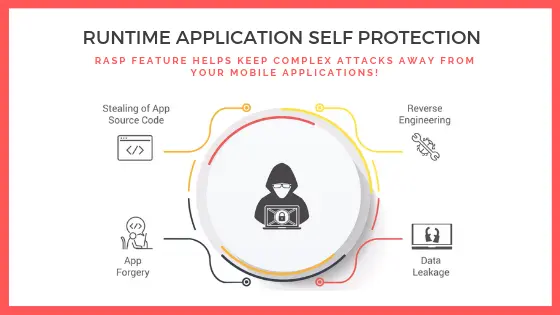It becomes critical to protect the apps from security threats more than before. Cyber threats have become more clever, and traditional SD protection is sometimes insufficient. This is where Runtime Application Self-Protection, or RASP is helpful. RASP is one of the newest security systems that guard applications from the inside and does not stop its protection after an attack or another threat takes place. In this post, we will review the basic elements of RASP that every developer, business executive, and IT specialist should know.
Runtime Application Self-Protection
It is a security technology that executes directly from the application and is also known as the runtime application self-protection. Because RASP is built into the program, RASP can protect itself in real-time when it is running as an application, unlike traditional security approaches that occur at the network or system level.
RASP works in the manner that it constantly analyzes the activities of the application as well as the environment. Therefore it can detect and prevent assaults in progress besides detecting an assault still in its early stages regardless of before recognizing specific patterns or signatures. RASP has a different viewpoint which allows it to understand structures, data flow, and execution environment because it works inside of the program. One of the advantages of RASP is that You can use it to secure all the stages of the application life cycle.
RASP Works
In essence, RASP works by modifying the code that is in the application. By employing instrumentation, RASP can monitor the activities of the application and prevent potentially dangerous actions from taking place. It begins with the application launch when RASP moves to the runtime environment and settles there.
After integration, RASP monitors user inputs, system interactions, and the application’s execution flow continually. It searches for patterns or actions, including SQL injection attempts, cross-site scripting, or illegal access to private information, that could point to an attack. RASP can respond quickly in the event of a potential threat. This includes stopping suspicious activities, ending user sessions, and notifying security staff.
RASP’s profound comprehension of the application’s context is the source of its efficacy.
Benefits of RASP
The capacity of RASP to offer real-time protection against a variety of threats is one of its main advantages. RASP can stop possible harm before it starts by detecting and responding to attacks as they happen from within the application. In today’s fast-paced digital environment, when new vulnerabilities and attack routes appear regularly, this real-time defense is very useful.
The versatility of RASP is yet another important benefit. RASP can learn and adjust to emerging threats over time, in contrast to static security solutions that depend on predetermined rules or signatures. RASP is especially successful against zero-day exploits and other cutting-edge attack techniques that might evade conventional defenses because of its dynamic security strategy.RASP provides insightful information about application security as well.
RASP vs. Traditional Security Measures
Mainstream security practices therefore act on the network or system level which include the likes of intrusion detection systems and firewalls. These technologies are crucial parts of an all-encompassing security plan, but they frequently don’t offer the deep application-level insights that RASP does. By incorporating an additional layer of security that runs inside the application, RASP enhances these conventional methods.
RASP is not a standard security tool; instead, it uses more than just pre-established criteria or signatures to identify risks. Rather, it recognizes possible attacks based on its comprehension of the behavior and context of the application. By using this method, RASP can identify and stop even highly skilled or unknown attacks that could evade conventional security measures.RASP’s capacity to offer instant protection without requiring modifications to the application code or other components is another significant distinction.
Challenges and Considerations
Although RASP has several advantages, its proper implementation necessitates careful thought. Making sure that RASP integration doesn’t impair application performance is one of the main challenges. Because RASP functions inside the program, it’s critical to select a solution that reduces overhead while preserving the best possible application responsiveness and speed.
The extent of protection is a further crucial factor. Various RASP solutions might concentrate on particular threat categories or programming languages. Make sure the RASP solution you choose addresses the unique security concerns you encounter and is compatible with the technological stack of your application.
Another important thing to think about is integration with the current security infrastructure. RASP shouldn’t completely replace your present security procedures; rather, it should strengthen and supplement them.
The Future of Application Security
RASP will probably play a bigger part in application security as long as cyber threats keep evolving. We anticipate that RASP will be used more frequently in a variety of businesses, especially those that deal with sensitive data or vital infrastructure. It’s also conceivable that technology itself will progress, leading to increases in integration capabilities, performance optimization, and threat detection accuracy.
It is anticipated that RASP solutions will incorporate more machine learning and artificial intelligence to improve their capacity to identify and counter sophisticated, dynamic threats. Additionally, RASP and other security technologies might integrate more closely, resulting in more complete and efficient security ecosystems. Real-time, context-aware protection
offered by RASP will be even more important as applications get more complicated and distributed. As we’ve seen, RASP has many advantages, including timely threat identification and prevention as well as insightful security information. Effective RASP implementation, however, necessitates giving considerable thought to many aspects, including performance impact, system integration, and alignment with particular security requirements.
In the future, RASP will likely become even more crucial to application security. The technology will surely become an essential part of all-encompassing security methods as it develops and matures.
Conclusion
A major advancement in application security is rasp security . As the name implies, RASP provides context-aware and real-time protection from within the application and renders a strong guard against several common cyber threats. RASP is an essential tool for modern site protection even it is not effective in all cases concerning site protection from various sorts of threats.






Be First to Comment